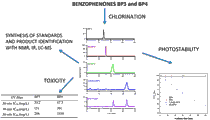Stability and Toxicity of Selected Chlorinated Benzophenone-type UV Filters in Waters
Keywords:
UV filter, photostability, chlorination, toxicity, Vibrio fischeriAbstract
In our study, the transformation of two most widely used UV filters, benzophenone-3 (BP3) and benzophenone-4 (BP4), in chlorinated water with disinfection reagents sodium hypochlorite (NaClO) and trichloroisocyanuric acid (TCCA) was studied. Based on the HPLC/MS and UV-Vis analysis the formation of two different chlorinated products (5-chloro- 2-hydroxy-4-methoxybenzophenone and 3,5-dichloro-2-hydroxy-4-methoxybenzophenone) was established. Identity of chlorinated products was confirmed by means of comparison of retention times with independently synthesized standards. Photostability study showed that dichloro-derivative in water is less stable then parent compounds, which is not the case for monochloro-derivatives. Toxicity of chlorinated compounds tested by Vibrio fischeri was found to be in the same range as that of the starting compounds. Preliminary testing of real water samples from swimming pools and sea swimming areas confirmed the presence of BP3 and its 3,5-dichloro derivative.

Downloads
Published
Issue
Section
License
Except where otherwise noted, articles in this journal are published under the Creative Commons Attribution 4.0 International License
